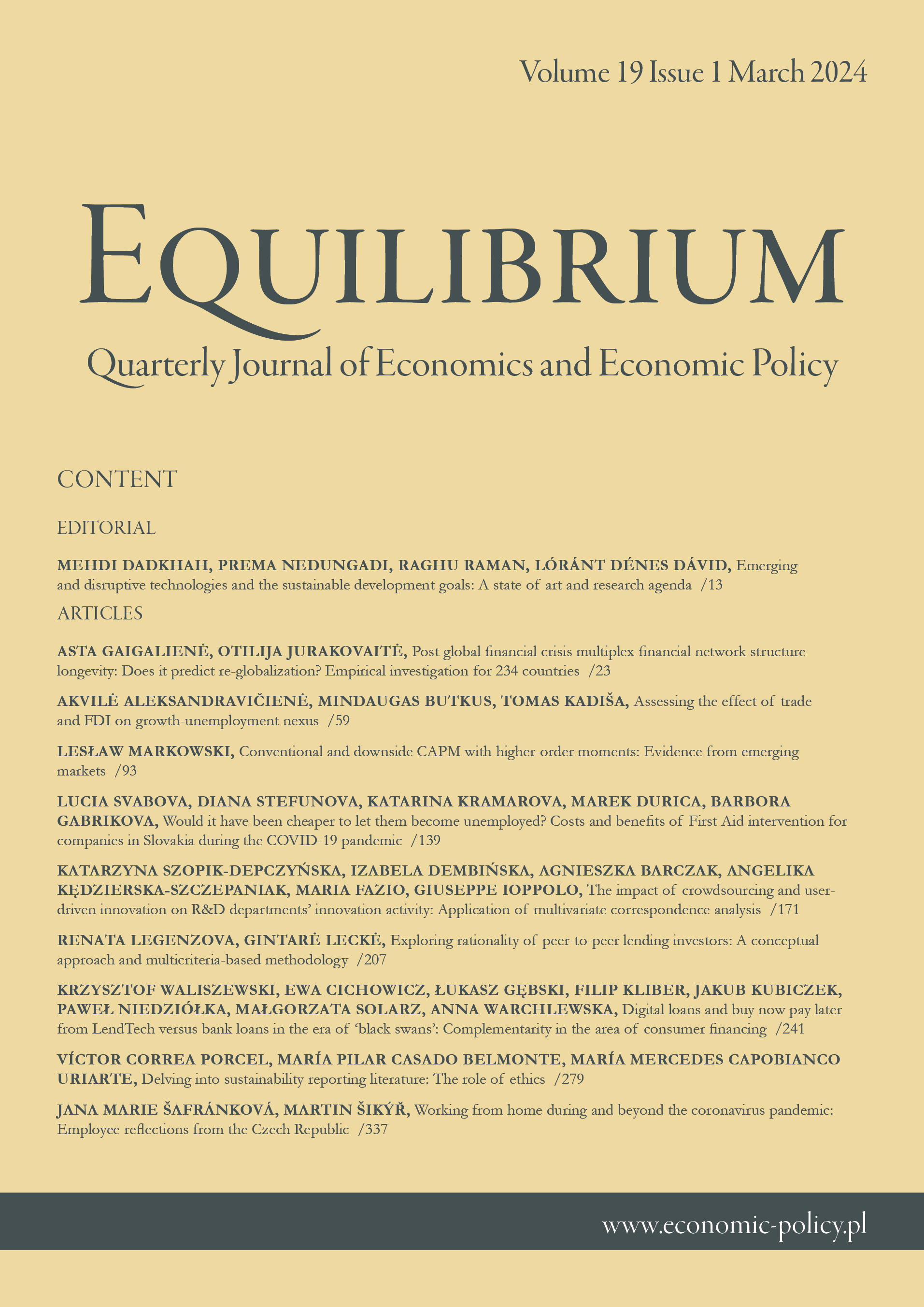波兰经济周期波动的概率预测分析
IF 6.2
Q1 ECONOMICS
Equilibrium-Quarterly Journal of Economics and Economic Policy
Pub Date : 2017-09-30
DOI:10.24136/EQ.V12I3.23
引用次数: 7
摘要
研究背景:在现代实证宏观经济学中,包括对经济周期波动的分析在内,概率设置和对不确定性和风险评估的关注已经变得越来越普遍。因此,基于预测的未来经济状况指标应该使用密度预测而不是点预测来构建,因为密度预测提供了预测不确定性的描述。本文的目的:我们讨论了波兰经济周期波动的基于模型的概率推断。特别地,我们考虑了波兰工业生产增长率概率预测的模型比较。我们还开发了一类使用概率信息构建的未来经济状况指标(利用几个预测范围内的联合预测分布)。方法:我们使用贝叶斯方法(为了捕捉估计的不确定性),并考虑两组模型。第一组由具有广义t条件分布的动态条件分数模型组成(具有条件异方差和重尾,对于极端观测的建模很重要)。另一组模型依赖于使用柔性傅立叶形式的确定性周期建模。使用概率预测标准:对数预测分数(LPS)和连续排名概率分数(CRPS)对模型的事后密度预测性能进行了比较。发现和附加价值:2013年前的数据支持确定性周期模型,而最近的观测结果可以用简单的均值回归高斯AR(4)过程来解释。结果表明,2013年后波兰经济周期波动受到结构性变化的影响。因此,建议使用预测池策略作为进一步研究的工具。我们发现支持第一组模型的人相当有限。这里考虑的未来经济状况的概率指标很好地引导了增长周期的实际阶段,尽管2013年之后的影响不那么明显。本文章由计算机程序翻译,如有差异,请以英文原文为准。
Probabilistic predictive analysis of business cycle fluctuations in Polish economy
Research background: The probabilistic setup and focus on evaluation of uncertainties and risks has become more widespread in modern empirical macroeconomics, including the analysis of business cycle fluctuations. Therefore, forecast-based indicators of future economic conditions should be constructed using density forecasts rather than point forecasts, as the former provide description of forecast uncertainty. Purpose of the article: We discuss model-based probabilistic inference on business cycle fluctuations in Poland. In particular, we consider model comparison for probabilistic prediction of growth rates of the Polish industrial production. We also develop a class of indicators of future economic conditions constructed using probabilistic information on the rates (that make use of joint predictive distribution over several forecast horizons). Methods: We use Bayesian methods (in order to capture the estimation uncertainty) and consider two groups of models. The first group consists of Dynamic Conditional Score models with the generalized t conditional distribution (with conditional heteroskedasticity and heavy tails, being important for modelling of extreme observations). Another group of models relies on deterministic cycle modelling using Flexible Fourier Form. Ex-post density forecasting performance of the models is compared using the criteria for probabilistic pre-diction: Log-Predictive Score (LPS) and Continuous Ranked Probability Score (CRPS). Findings & value added: The pre-2013 data support the deterministic cycle models whereas more recent observations can be explained by a simple mean-reverting Gaussian AR(4) process. The results indicate a structural change affecting Polish business cycle fluctuations after 2013. Hence, forecast pooling strategies are recommended as a tool for further research. We find rather limited support in favor of the first group of models. The probabilistic indicator of future economic conditions considered here leads actual phases of the growth cycle quite well, though the effect is less obvious after 2013.
求助全文
通过发布文献求助,成功后即可免费获取论文全文。
去求助
来源期刊
CiteScore
9.20
自引率
3.50%
发文量
28
审稿时长
36 weeks
期刊介绍:
Equilibrium. Quarterly Journal of Economics and Economic Policy is a scientific journal dedicated to economics, which is the result of close cooperation between the Instytut Badań Gospodarczych/Institute of Economic Research (Poland) and Polish Economic Society and leading European universities. The journal constitutes a platform for exchange of views of the scientific community, as well as reflects the current status and trends of world science and economy.
The journal especially welcome empirical articles making use of quantitative methods in: Macroeconomics and Monetary Economics, International Economics, Financial Economics and Banking, Public Economics, Business Economics, Labor and Demographic Economics, Economic Development, and Technological Change, and Growth.
Current most preferable topics and special issues:
The economics of artificial intelligence: business potentials and risks;
Digitalization and entrepreneurship in economics;
Sustainable socio-economic development, environmental and ecological economics;
Transition in the energy market (improving energy efficiency, alternative energy sources, renewable energy, energy security).

 求助内容:
求助内容: 应助结果提醒方式:
应助结果提醒方式:


